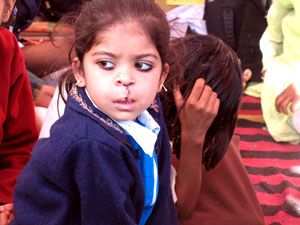Indians still dying 25 years after toxic gas leak
By Chryso D'Angelo | Last updated: Dec 18, 2009 - 6:20:22 PMWhat's your opinion on this article?

NEW YORK (IPS/GIN) - “I saw the leaves on the trees curl and turn black and birds fall dead out of the sky, I knew that this was Death, come among us as foretold. My regret is that I survived,” said a native of Bhopal, India after a toxic gas leak at a pesticide plant 1984. Photo: Amnesty International/Ellen Shifrin
|
Between 8,000-10,000 died when the escaped gas engulfed their homes. A quarter century later, the disaster continues to unfold, an independent watchdog group says, citing chronic health problems among area residents.
According to a new report, “Analysis of Chemical Contaminants in Groundwater of Communities Surrounding UCIL Plant Site in Bhopal,” released Dec. 2 by the Britain-based Bhopal Medical Appeal (BMA), the Union Carbide plant, currently owned by Dow Chemical Company, is allegedly poisoning the people of Bhopal as methyl isocyanate gas leaks into the community's soil and water aquifer.
Twenty years ago, Dow Chemical settled a class action lawsuit over the disaster and paid $470 million in damages to the Indian government, which then dropped criminal charges against the company. Dow says the state of Madhya Pradesh is now legally responsible for the site, and that Union Carbide had “worked diligently to provide immediate and continuing aid to the victims and set up a process to resolve their claims.”
Dow recently re-opened the pesticide plant for two weeks, “to help people get rid of the apprehension and misconception that the chemical wastes lying in the factory are still harmful and are polluting the ground water of the nearby localities,” according to Babulal Gaur, rehabilitation minister of Bhopal Gas Tragedy Relief, a government agency in Madhya Pradesh.
Critics argue that the opening, and tests administered by Indian laboratories that deem the area safe, are stunts intended to fool the community so the plant can swing back into operation and plant owners and municipalities can shirk their responsibilities for the medical care of local residents.
“Our report demonstrates that an Indian laboratory, contracted to test water samples, had not provided the correct results,” Colin Toogood, who co-authored the report, told IPS. “A duplicate of three of the samples was tested in an accredited laboratory in Switzerland and found all of the toxic chemicals we were expecting to be present.”
According to the BMA, two decades of monsoons washed the chemicals, which were left in exposed drums after doors closed in 1984, deep into the soil and aquifers which feed wells and boreholes. These water sources supply an estimated 25,000 people.
In May 2004, the Supreme Court of India ordered that clean, safe water be piped into communities, but Mr. Toogood says the pipe network is inadequate. “It is damaged easily as it is laid on the surface of the ground, and the water supplied through it is inadequate and of poor quality,” he told IPS.
Side effects of the toxic poisoning to people in the vicinity of Bhopal include cancer, kidney damage, breathlessness, persistent cough, diminished vision, early age cataracts, loss of appetite, menstrual irregularities, recurrent fever, back and body aches, loss of sensation in the limbs, fatigue, and birth defects.
The BMA estimates that over 120,000 chronically ill survivors are in desperate need of medical attention and an estimated 10 to 15 people are dying every month from exposure-related illnesses. It asserts that the Bhopal Memorial Hospital and Research Centre, which is meant to prioritize gas victims, routinely denies patients kidney dialysis and give priority to paying patients.
A Day of Action took place Dec. 2 in Bhopal, London, San Francisco and Tel Aviv to raise awareness through mass rallies, candle-lit vigils, concerts and symbolic “die-ins.”
In the meantime, family members who survived the 1984 disaster question the luck of living through that fateful day in 1984 when those sleeping soundly were roused in the darkness by a burning sensation in their eyes, noses and throats.
“At about 12:20 a.m., I woke to the sound of my baby coughing badly,” said Aziza Sultan, a survivor, in the report. “In the half light, I saw that the room was filled with a white cloud. I heard a lot of people shouting. They were shouting ‘run, run.' Then I started coughing with each breath, seeming as if I was breathing in fire. My eyes were burning.”
“The gases burned the tissues of their eyes and lungs and attacked their nervous systems. People lost control of their bodies. Urine and feces ran down their legs. Women lost their unborn children as they ran, their wombs spontaneously opening in bloody abortion,” according to a 1994 BMA report.
“Carbide has never shown any interest in the condition of its victims,” said Sunil Kumar, who lost his family during the original gas leak. “We've always known that. Now it seems they know that their factory is poisoning a whole new generatio—and they are doing nothing to stop it. There are many deformed births. It's as if they really hate us. As if they are trying to punish us for protesting when they gassed us before and killed our families. What kind of people are they to do this?”
INSIDE STORIES AND REVIEWS
-
-
About Harriett ... and the Negro Hollywood Road Show
By Rabiah Muhammad, Guest Columnist » Full Story -
Skepticism greets Jay-Z, NFL talk of inspiring change
By Bryan 18X Crawford and Richard B. Muhammad The Final Call Newspaper @TheFinalCall » Full Story -
The painful problem of Black girls and suicide
By Charlene Muhammad -National Correspondent- » Full Story -
Exploitation of Innocence - Report: Perceptions, policies hurting Black girls
By Charlene Muhammad -National Correspondent- » Full Story -
Big Ballin: Big ideas fuel a father’s Big Baller Brand and brash business sense
By Bryan Crawford -Contributing Writer- » Full Story






 Click Here Stay Connected!
Click Here Stay Connected!








